


KRIM |
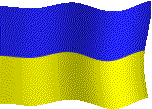
UKRAINE UKRAINA |
5 SEPTEMBER
The Day I Became A Spy
SEVASTOPOL The early light fell onto my face, and it suddenly occurred to me that a sunrise view of Chersonesus might be worth an early rise. I hopped out of bed, had a quick wash of my face – not much effort was required for the water pump simply wasn’t strong enough. Caught hold of my camera and out I went to the seaside. By then it was too late for the sunrise but the freshness of the day was pleasant enough. I explored the ancient ruins and the mosaics. Amazing sight – until recently, I could hardly imagine myself spending the night in the ruins of a Greek city and even more inconceivably, a Greek city in Ukraine !
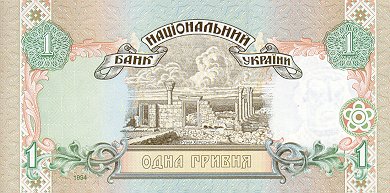 Chersonesus on the Ukrainian 1H banknote
Chersonesus on the Ukrainian 1H banknote
I wasn’t the only visitor at this time. The park is open to the
public from sunrise, and people were jogging among the ruins, and some
were on the beach. Do you fancy swimming next to Corinthian columns
? I stood next to the columns, looking at the harbour gates.
These formidable-looking walls guarded the narrow entrance to a huge multi-cove
bay that is Sevastopol’s naval port. I wondered how many died defending
this strategic spot. Half a million on both sides of the Crimean
War, and perhaps an equal number if not more during the WWII.
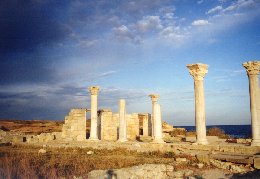 |
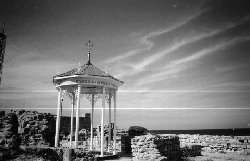 |
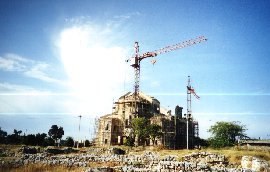 |
|
|
the Baptism of the Rus |
|
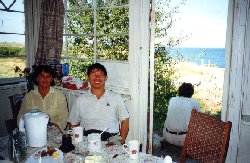 |
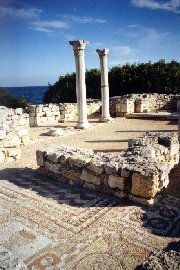 |
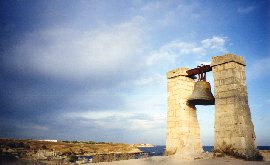 |
|
|
|
|
A few babushkas were making their way to the church for prayers. A booth stood round the corner, for the collection of donations for the rebuilding of the Cathedral (destroyed during WWII) that once stood there, commemorating the conversion of Vladimir (Volodymyr in Ukrainian), Prince of Kyiv, to Orthodox Christianity, in Chersonesus. A pavilion stood at the spot where he was baptised in 988 AD. Chersonesus was first founded as a Greek city-state, became Roman, and then Byzantine. In 988 AD, Prince Vladimir conquered the city, and in return for marrying the Emperor’s sister, Princess Anna, he agreed to return Chersonesus to the Byzantine Empire and becoming a Christian. With that, the Russian Orthodox Church was founded.
I returned to the cottage and had breakfast with Galina, while listening to the waves and the seagulls… We bid farewell, and as we were about to leave the Park, the naval base next door was blaring out the Russian national anthem. A strategic location is as much a blessing as a curse. When will the next bullet be fired ?
Our first conquest of the day was the Crimean War Panoramic Museum. This is a huge round building with a panoramic painting of the defense of Sevastopol. Completed in 1904, this massive work commemorated the heroic defense of the city against the onslaught of British, French and Turkish forces in 1853-6. During the WWII, the painting was damaged in many areas, and Soviet troops risked their lives trying to save it. It was smuggled out of the besieged city and eventually restored and reopened to the public in 1954.Military monuments and memorials dotted this city. The streets
are paved with heroic tales and legends. No wonder it has such a
special place in the hearts of the Russian people. Hence the emotions
that flared up since the downfall of the USSR.
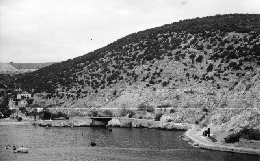 |
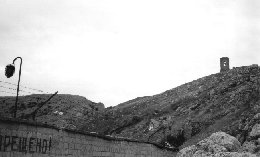 |
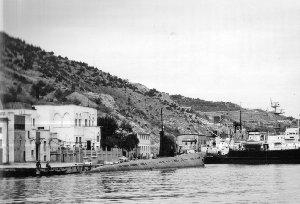 |
|
|
|
|
We also visited the WWII Monument. Located on a hill overlooking
a wide expanse of vineyards and fields to the south. At the far end
is the Genoese fortress at Balaclava. We drove there in no time.
Here, at this narrow winding fjord, submarines berthed alongside fishing
boats, while sunbathers enjoyed the summer tan. Not far from here
was the field where Lord Cardigan’s Light Brigade charged to their deaths
in an episode that so bizarrely fascinated military historians even today.
Standing on the slopes leading to the Genoese Chembalo Fortress last used
during the Ottoman conquest, the almost hidden entrance to an once-secret
submarine base built under the mountain could be seen. According
to Yevgeny, this was so secret that the American satellites never discovered
its existence until the end of the Cold War. From total secrecy to
total openness. I happily snapped away pictures of submarines and
battleships. Anyone interested in pictures of the Black Sea Fleet
? They go to the highest bidder!
Ancient Tribes and Modern-day Junkies
MANGUP KALE Mangup Kale was next. We drove eastwards across wheat, sunflower and vegetable fields. After more than an hour, we passed a beautiful meadow by a lake. To the other side was a lush green valley with a few tall limestone plateaus. Yevgeny pointed to one of them at the end of the valley, “That’s Mangup”. Here, newly-returned Tatars have built a new village. Men were erecting little houses with corrugated aluminum roofs while the women were with the crops. “It’s a hard life,” Yevgeny said. These Tatars have arrived in a homeland full of strangers, many of whom distrust them. There is no more land for them and they often have to settle in remote and less fertile areas. Even then, decades of hardship in the Central Asian deserts have taught them not only endurance, but also the magic of making the desert bloom. Crimea can’t be a problem for them. They have since improved the diet of all in Crimea, with the best, cheapest and the freshest vegetables and fruits one can find. We parked the car in front of a Tatar house and Yevgeny shouted for an order for Pilov (Uzbek fried rice) and Manty (Central Asian dumplings). We would return for a late lunch after visiting Mangup Kale.
Then we began our walk to the Kale, or fortress in Turkish or Tatar. There is nothing but a muddy track through the dense forest. It certainly wasn’t a very encouraging start when rain began to fall. We hurried into the dense canopy for shelter. The place looked deserted but occasionally we passed a few hikers. “Dobry Dan. Dzharviste !” And then it became eerie again, the only noise being the running stream and the whirring of cicadas. We passed by some ancient Karaim tombs, many of which still had engravings in Hebrew. I was certain there were more eyes than ours around, and the feeling of being stared at by the unknown wasn’t the most pleasant of feelings. And yes, like anyone else from the Far East, even a supposedly pseudo internet-savvy investment banker like me is always aware of the thin line between the physical world and its supernatural counterpart.
Two hours lapsed as we emerged from the forest into an almost treeless, flat plateau. By then, we were panting heavily. Heavens must be jealous of our achievement, as it began drizzling again. A lone figure in raincoat and a stick appeared from the misty horizon. We walked forward and Yevgeny greeted him like an old friend. It’s Dr Alexander Gertsen, a renowned archaeologist. Yevgeny seems to know all the archaeologists in Crimea. “I like unusual people,” he said. Lonely Planet doesn’t tell me much about Mangup, and I have by then forgotten Neal Ascherson’s description of the place and its history. And so I had a refresher course from Dr Gertsen, who despite his wretched drenched state, told me briefly about Mangup and the Feodoros.Although the evidence was by no means conclusive, Mangup was reportedly first founded in the 3rd century AD by nomadic Alans and Goths. They were initially a vassal of Byzantium, but soon became an integral part of the empire. The strategic and easily defensible fortress city meant that it became the place of refuge whenever a new group of invading nomads entered Crimea. The city was later captured by the Khazars, another nomadic group, but in 787 AD, Prince-Metropolitan John the Goth led a rebellion against the Khazars, thus founding the principality of Feodoros, which lasted until 1475, when the Ottomans came. The Turks laid siege to Mangup for six months, and finally using the technique they deployed in Constantinople, that is, concentrated cannon fire with granites weighing 100 kilograms each on a few specific locations, they breached the wall and ended the principality once and for all. The Karaims stayed here for a while, and even they left in 1792.
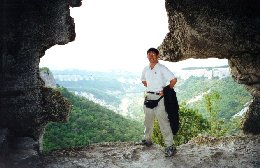 We
walked around the barren top of the plateau, admiring the sweeping landscape
and panoramic view. On a clear day, one could see the Black Sea coast.
I suppose Feodoros planners were once on the lookout for the latest reinforcement
of Ottoman troops, which meant that their cause could only be getting worse
by the day. We caught sight of a representative of Mangup’s modern
day inhabitants – local hippies. The blond, cock-eyed girl (yes,
another blond) carried a bundle of wood past us in the opposite direction.
Goodness me, she did not even blink her eyes, merely walking straight and
stiff. It was as though we were invisible ! She reminded me
of the possessed ones in all time family movies like Omen and Exorcist.
Or like that sexy though possessed lady in Ghostbusters who I vaguely remembered
having said something like “I’m the Gate-Keeper. Are you the Key-Master
?”
We
walked around the barren top of the plateau, admiring the sweeping landscape
and panoramic view. On a clear day, one could see the Black Sea coast.
I suppose Feodoros planners were once on the lookout for the latest reinforcement
of Ottoman troops, which meant that their cause could only be getting worse
by the day. We caught sight of a representative of Mangup’s modern
day inhabitants – local hippies. The blond, cock-eyed girl (yes,
another blond) carried a bundle of wood past us in the opposite direction.
Goodness me, she did not even blink her eyes, merely walking straight and
stiff. It was as though we were invisible ! She reminded me
of the possessed ones in all time family movies like Omen and Exorcist.
Or like that sexy though possessed lady in Ghostbusters who I vaguely remembered
having said something like “I’m the Gate-Keeper. Are you the Key-Master
?”
The basilica and citadel stood above all. Obviously this was a lonely place with few visitors. One could still see remnants of Byzantine architectural styles. At the pointed end of the plateau was a series of caves, one of the many that’s found on this cheesecake-like plateau. Glorious panoramic view and occasional sign of recent human occupation – piles of burnt wood, some rubbish, etc. I could imagine the hippies doing a joint here. Later, on our way downhill, we even passed two hippy blokes and a girl – all in their twenties, shoulder-length hair and ear piercings.
We returned to the Tatar house and were invited to sit on the family takhta, a raised bed-like platform covered with a Bukhara carpet. This reminded me of the many hours I had spent in an Uzbek chaikhanna, or tea house, together with overwhelming local hospitality. The sun-burnt, bare-chested late twenty-plus Son was chopping a tree trunk for fire wood, while wrinkled Mummy in her bright rainbow-coloured Uzbek gown and Daddy in his black-white skullcap served us great chai, or tea. “Salaam aley-kum” I greeted Mummy and Daddy Tatar using the standard Islamic phase, Peace be with you. They were delighted and asked if I was a fellow believer. I surprised them by saying that I’m not, but I come from a part of the world with many Muslims, and have been to many Islamic lands. Yevgeny told them that I have been to over 50 countries. They were impressed, but that hit Mummy Tatar’s sore point too. She was very distressed that she didn’t have enough money to buy an air ticket to the Urals to visit her daughter, while days before I was still wondering how I could reach the 118-country achieved by the Spaniard I met in Vilnius.We returned to Simferopol in time for a great dinner prepared by Vera. This time it’s pepper and rice, coupled with great Crimean wines. Heres, Massandra and all.
![]() 6
SEPTEMBER: CRIMEA: SUDAK & JOURNEY TO ODESSA: Great Wall of China ?
6
SEPTEMBER: CRIMEA: SUDAK & JOURNEY TO ODESSA: Great Wall of China ?
| RETURN TO FROM THE BALTIC TO THE BLACK SEA HOMEPAGE |